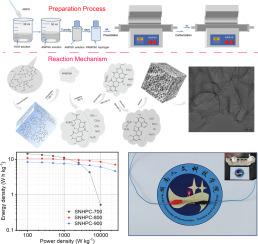One-tube self-activation of hydrogel for the preparation of hydrophilic N, S co-doped hierarchical porous carbon: Formation mechanism and supercapacitor performance
IF 8.9
2区 工程技术
Q1 ENERGY & FUELS
引用次数: 0
Abstract
The porous carbon of supercapacitors usually is synthesized via an activation procedure based on traditional activators, such as KOH, H2O, and CO2. Herein, a self-activation strategy is proposed to prepare N/S co-doped hierarchical porous carbons (NSHPC). Poly(2-acrylamide-2-methylpropane sulfonic acid potassium) (PAMPSK) hydrogels as precursors are obtained via a self-polymerized reaction, and they are annealed at 800 °C to result in NSHPC-800 with the best properties. NSHPC-800, used as electrode materials for supercapacitors, exhibits a prominent rate capability of 256.2 F g−1 at 50 A g−1. Moreover, the symmetric supercapacitor exhibits a high energy density of 7.08 Wh kg−1 at ultrahigh power density of 25,000 W kg−1. Two capacitors are connected in series to light up a red light emitting diode for 60 s. This work may provide a new strategy for the synthesis of hydrophilic porous carbons, as well as a systematic investigation of the self-activation process and mechanism.

制备亲水性N, S共掺杂层叠多孔碳的单管自活化水凝胶:形成机理和超级电容器性能
超级电容器的多孔碳通常是通过基于传统活化剂(如KOH、H2O和CO2)的活化程序合成的。本文提出了一种自激活策略来制备N/S共掺杂层次化多孔碳(NSHPC)。通过自聚合反应得到聚(2-丙烯酰胺-2-甲基丙烷磺酸钾)(PAMPSK)水凝胶为前驱体,并对其进行800℃退火,得到性能最佳的NSHPC-800。作为超级电容器的电极材料,NSHPC-800在50 a g−1时表现出256.2 F g−1的显著速率能力。在25000 W kg−1的超高功率密度下,对称超级电容器的能量密度高达7.08 Wh kg−1。两个电容器串联在一起,点亮一个红色发光二极管60秒。本研究为亲水性多孔碳的合成提供了新的思路,并对其自活化过程和机理进行了系统的研究。
本文章由计算机程序翻译,如有差异,请以英文原文为准。
求助全文
约1分钟内获得全文
求助全文
来源期刊

Journal of energy storage
Energy-Renewable Energy, Sustainability and the Environment
CiteScore
11.80
自引率
24.50%
发文量
2262
审稿时长
69 days
期刊介绍:
Journal of energy storage focusses on all aspects of energy storage, in particular systems integration, electric grid integration, modelling and analysis, novel energy storage technologies, sizing and management strategies, business models for operation of storage systems and energy storage developments worldwide.
 求助内容:
求助内容: 应助结果提醒方式:
应助结果提醒方式:


